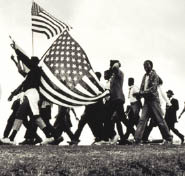On the Road to Freedom Exhibit
by Peter Koch

The road to freedom for blacks in Buffalo has always been a significant, if not entirely bumpy, one. Throughout its rich history, the city’s been in the forefront of the civil rights movement, seesawing from the progressive to the shameful. Throughout the 1800s, Buffalo, with its close proximity to Canada, served as an important stop along the Underground Railroad. At the 1843 Negro National Convention here, Frederick Douglass debated in favor of nonviolent protest against Rev. Henry Garnet. Later, U.S. President and Buffalo-native Millard Fillmore signed the Compromise of 1850, which included a stronger Fugitive Slave Law that required citizens of northern states to actively aid in the capture of runaways living amongst them. When the U.S. Supreme Court declared segregation unconstitutional in 1954, the Buffalo Board of Education was backsliding by actively bolstering its segregation policies. These snapshots from Buffalo’s civil rights history have been woven into an in-depth mosaic that is currently on display as the Buffalo & Erie County Historical Society’s “On the Road to Freedom” exhibit. This Sunday, Historical Society Executive Director, William H. Seiner, conducts a public tour of the exhibit and offers his own expertise and valuable insight into those critical times.
Sunday, February 5 at 1:30pm. Buffalo and Erie County Historical Society, 25 Nottingham Court (873-9644). Free with gallery admission ($6 general, $4 for seniors and students, and $2.50 for children ages 7 to 12).
|
Issue Navigation> Issue Index > v5n5: Suing the Governor (2/2/06) > See You There > On the Road to Freedom Exhibit This Week's Issue • Artvoice Daily • Artvoice TV • Events Calendar • Classifieds |









 Current Issue
Current Issue